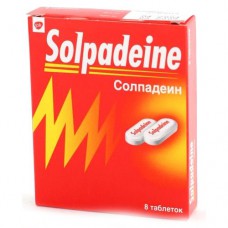Expiration date: 03/2026
Form and composition:
Soluble tablets white color, flat, with facet, smooth on one side and scored on the other.
1 tablet contains:
paracetamol 500 mg
codeine phosphate 8 mg
caffeine 30 mg
Excipients: sodium bicarbonate, sorbitol, sodium saccharin, sodium lauryl sulfate, citric acid anhydrous, sodium carbonate anhydrous, polyvidon, Dimethicone.
2 PCs. - strips (2) - cardboard boxes.
2 PCs. - strips (4) - cardboard boxes.
2 PCs. - strips (6) - cardboard boxes.
2 PCs. - strips (12) - cardboard boxes.
2 PCs. - strips (30) - cardboard boxes.
Pharmacological action:
Analgesic-antipyretic combined composition, contains a combination of three active ingredients.
Paracetamol has antipyretic and analgesic action.
Caffeine has a General tonic effect (reduces drowsiness and fatigue, increases mental and physical performance, increases heart rate, increases blood PRESSURE in hypotension), increases the analgesic effect of the drug.
Codeine has an analgesic effect and improves pain tolerance.
Pharmacokinetics:
Data on the pharmacokinetics of the drug Ointment is not available.
Indications:
Pain syndrome in adults and children over 12 years, including:
- headache
- toothache
- migraine
- pain in muscles and joints
- neuralgia
- painful menstruation
- radiculitis
- in tension
- sinusitis.
- sore throat.
To reduce the increased body temperature in adults and children over 12 years with colds, other infectious and inflammatory diseases and influenza.
Dosage regimen:
Adults are prescribed 2 tab. 3-4 times/day at intervals of no less than 4 hours the Maximum single dose of 2 tab., the maximum daily dose - 8 tab.
Children aged 12 to 16 years appoint 1 tab. 3-4 times / day at intervals of not less than 4 hours Maximum single dose of 1 tab., the maximum daily dose - 4 tab.
Tablets before taking should be dissolved in half a glass of water.
The drug should not be taken more than 5 days when administered as an anesthetic and more than 3 days as a antipyretic. Changing the dose and interval between doses set by the doctor.
Side effect:
From the digestive system: nausea, epigastric pain rarely-constipation.
Allergic reactions: skin rash, itching, urticaria, angioedema.
From the hematopoietic system: very rare-anemia, thrombocytopenia, methemoglobinemia.
From the Central nervous system: rarely-sleep disturbance, drowsiness, dizziness.
Other: palpitations.
With long-term use in doses significantly exceeding the recommended ones, the likelihood of liver and kidney dysfunction increases.
Contraindications:
- expressed violations of liver or kidney function
- blood diseases (thrombocytopenia, anemia)
- genetic absence of glucose-6-phosphate dehydrogenase
- glaucoma
- respiratory failure, conditions after traumatic brain injury, increased intracranial pressure
- arterial hypertension
- simultaneous reception of other paracetamol-containing agents
- pregnancy
- period of breastfeeding
- child age (up to 12 years)
- increased individual sensitivity to paracetamol, codeine, caffeine or any other ingredient of the drug.
With caution, the drug should be used for Gilbert's syndrome (constitutional hyperbilirubinemia), congenital hyperbilirubinemia (Dubin-Johnson and Rotor), bronchial asthma, as well as in the elderly.
Pregnancy and lactation:
The drug is contraindicated in pregnancy and during breastfeeding.
Special instruction:
With caution, Solpadeine should be prescribed for bronchial asthma or other diseases of the respiratory system, while taking antidepressants, antiemetic drugs, as well as hypolipidemic drugs.
During the reception of the drug is not recommended excessive use of tea and coffee, because it can lead to excitation, sleep disturbance, tachycardia, cardiac arrhythmia.
With long-term use in doses significantly exceeding the recommended ones, it is necessary to control the picture of peripheral blood.
To avoid liver toxicity, patients taking Solpadeine should refrain from drinking alcohol. It is not recommended to prescribe the drug for chronic alcoholism.
Since the drug includes codeine, it should be borne in mind the possibility of developing addiction.
Impact on the ability to drive and operate machinery
Solpadeine can cause drowsiness. In this case, when taking Solpadeine, one should refrain from driving and engaging in potentially dangerous activities that require increased concentration and speed of psychomotor reactions.
Overdose:
In case of overdose, you should seek medical help immediately, even if you feel well.
Symptoms: nausea, vomiting, stomach pain, sweating, pale skin, tachycardia with mild intoxication - ringing in the ears with severe intoxication - confusion, drowsiness, collapse, convulsions, bronchospasm, difficulty breathing.
Treatment: do gastric lavage, prescribe adsorbents (activated carbon), conduct symptomatic therapy.
Drug interaction:
When taken for a long time Solpadeine increases the effect of indirect anticoagulants (warfarin and other coumarins), which increases the risk of bleeding.
Inductors of microsomal oxidation in the liver (phenytoin, phenytoin, ethanol, barbiturates, carbamazepine, flumecinol, rifampicin, zidovudine, phenylbutazone and tricyclic antidepressants) increase the production of hydroxylated active metabolites, resulting in the possibility of severe intoxication with a slight excess of the dose.
Inhibitors of microsomal oxidation (including cimetidine) reduce the risk of hepatotoxic paracetamol.
Metoclopramide and domperidone increase, and colestyramine reduces the rate of absorption of paracetamol.
Solpadeine while the use reduces the effectiveness of uricosuric drugs.
Caffeine accelerates the absorption of ergotamine.
Codeine increases the effect of sleeping pills, analgesics and sedatives.
Ethanol increases T1 / 2 paracetamol, increasing the risk of hepatotoxic action.
Storage conditions and terms:
The drug should be stored out of reach of children at a temperature no higher than 25°C. shelf life - 4 years.



